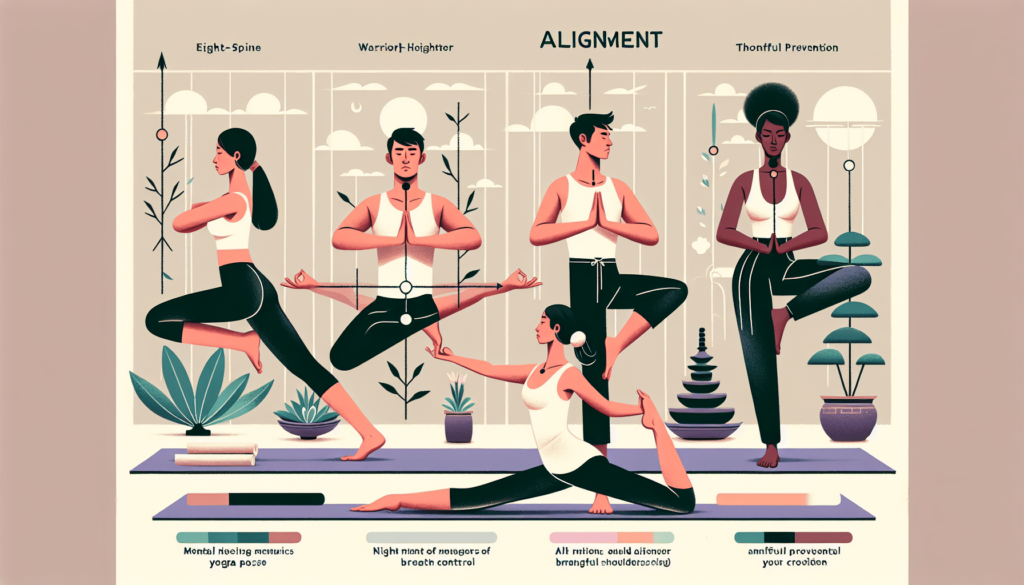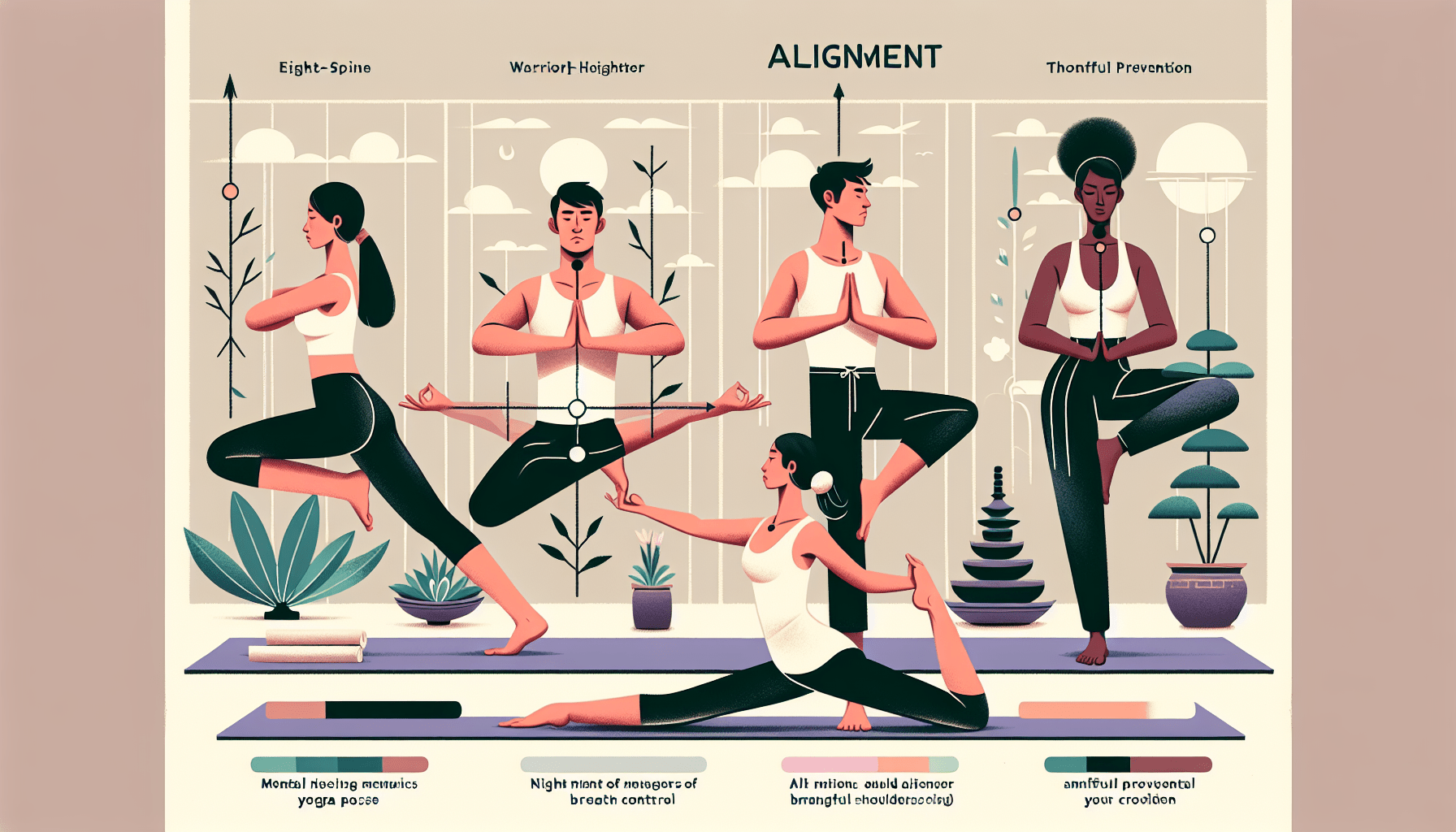In the world of yoga, alignment plays a crucial role in achieving the full benefits of the practice. Whether you’re a beginner or experienced yogi, understanding the importance of alignment can significantly enhance your practice. By aligning your body in the correct posture, you not only prevent injuries but also allow energy to flow freely through your body, promoting physical and mental well-being. So, let’s embark on a journey together, where we’ll explore the significance of alignment in yoga and how it can transform your practice for the better.

What is Alignment in Yoga?
Definition of alignment
Alignment in yoga refers to the correct positioning of the body in various yoga poses, also known as asanas. It involves aligning the muscles, bones, and joints in a way that promotes balance, stability, and proper function of the body. When practicing yoga, alignment is essential for maximizing the benefits of each pose and ensuring safety during the practice.
Importance of proper alignment
Proper alignment is crucial in yoga for several reasons. Firstly, it helps to prevent injuries by reducing strain on vulnerable areas such as the spine, knees, and wrists. Additionally, alignment improves the effectiveness of the pose by targeting the intended muscles and avoiding unnecessary tension in other areas. It also enhances balance, stability, and body awareness, allowing you to fully experience the benefits of the practice.
How alignment affects the body
Alignment has a profound effect on the body during yoga. When the body is aligned correctly, it allows for optimal energy flow and engagement of the targeted muscles. It also helps to improve posture, as it encourages the spine to align properly and reduces the tendency to slouch. Proper alignment can enhance strength and flexibility, as it ensures that the muscles are activated in the right way and prevents unnecessary strain on the joints.
Understanding the Benefits of Alignment
Improved posture and balance
Through proper alignment, yoga helps to improve your posture both on and off the mat. By aligning the spine and engaging the core muscles, yoga encourages an upright posture that reduces the strain on your back and neck. Better posture not only has physical benefits, such as reducing the risk of back pain, but it also promotes a more confident and poised appearance. Additionally, alignment in yoga poses enhances balance by centering your weight and improving overall body awareness.
Enhanced strength and flexibility
Alignment plays a pivotal role in developing strength and flexibility in yoga. When you align your body correctly, you can activate the targeted muscles effectively, making your practice more challenging and impactful. By engaging the muscles in the intended way, you can increase their strength and endurance over time. Proper alignment also allows for healthy and sustainable progression in flexibility, as it ensures that you stretch the appropriate muscles without straining or overextending.
Reduced risk of injury
One of the most significant benefits of alignment in yoga is its role in preventing injuries. When the body is aligned correctly, it reduces stress and strain on the joints, ligaments, and tendons. This ensures that the body moves safely through the poses, minimizing the risk of sprains, strains, and other yoga-related injuries. Through alignment, you can protect vulnerable areas such as the lower back, knees, and shoulders, allowing you to maintain a safe and sustainable yoga practice.
The Connection Between Alignment and Breath
Importance of breath awareness
Breath awareness is fundamental in yoga, as it helps to synchronize the body and mind. By consciously connecting to your breath, you bring focus to the present moment and cultivate a sense of calm and awareness. Breath awareness also helps to regulate the nervous system and reduce stress levels. It is a powerful tool for deepening your yoga practice and enhancing the mind-body connection.
How alignment supports proper breathing
Alignment plays a crucial role in supporting proper breathing during yoga. When the body is aligned correctly, it allows for the expansion of the chest and lungs, enabling deeper and more efficient breaths. Proper alignment of the spine and the engagement of the core muscles also provide a solid foundation for the breath to flow freely. With each inhale and exhale, alignment helps to create space within the body, allowing for a fuller, more nourishing breath.
Using alignment to deepen the breath
Alignment can be used as a tool to deepen the breath in yoga. By aligning the body in a pose, you create space for the breath to travel. You can focus on expanding the chest, lengthening the spine, and releasing tension in the shoulders and neck, allowing for a more expansive and unrestricted breath. As you deepen your awareness of alignment and breath, you can experience a profound sense of relaxation and connection within your practice.

Alignment as a Path to Mindfulness
Aligning the body and mind
Alignment in yoga serves as a bridge between the physical and mental aspects of the practice. As you align your body in each pose, you simultaneously align your mind, bringing your attention to the present moment. The process of aligning the body encourages you to let go of distractions and fully immerse yourself in the experience. This alignment of body and mind allows for a deeper state of mindfulness and connection to the present.
Increasing body awareness
Alignment practice in yoga cultivates a heightened sense of body awareness. By paying attention to the alignment of each body part, you develop a greater understanding of how your body moves and functions. This increased awareness extends beyond the yoga mat and translates into daily life, helping you to notice and correct imbalances or misalignments in your posture and movement patterns. Through alignment practice, you become more attuned to your body’s needs and maintain better overall physical well-being.
Developing a focused and present state of mind
When you bring attention to alignment in yoga, you develop a focused and present state of mind. As you concentrate on aligning your body, your mind naturally becomes absorbed in the task at hand. This focused state allows you to let go of distractions and worries, creating a sense of mental clarity and calm. By consistently practicing alignment in yoga, you can develop the ability to bring this focused and present state of mind into other areas of your life.
The Role of Alignment in Preventing Injuries
Common yoga injuries
While yoga is generally a safe and gentle practice, injuries can still occur. Some common yoga injuries include strains, sprains, and overuse injuries. Common areas prone to injury are the lower back, knees, shoulders, and wrists. These injuries can range from mild discomfort to more severe issues if not addressed properly.
How improper alignment contributes to injuries
Improper alignment is often a contributing factor to yoga-related injuries. When the body is not aligned correctly, it can lead to excessive strain on certain areas, causing overuse and discomfort. Misalignment can also result in uneven distribution of weight, putting excessive pressure on joints and causing instability. Additionally, improper alignment may compromise the integrity of certain poses, making them less effective and potentially increasing the risk of injury.
Using alignment to protect vulnerable areas
By focusing on alignment, you can protect vulnerable areas of your body during yoga practice. Proper alignment ensures that you distribute your weight evenly and avoid placing excessive stress on specific joints or muscles. For example, proper alignment in poses such as downward-facing dog can alleviate strain on the wrists. By understanding and practicing alignment cues, you can create a safe and supportive environment for your body, reducing the risk of injury and allowing for a sustainable and fulfilling yoga practice.
Alignment in Yoga Asanas
Alignment cues for foundational poses
In yoga, there are specific alignment cues that can help you achieve proper alignment in foundational poses. For example, in mountain pose, you align your feet hip-width apart with your toes pointing forward, engage your core, and lengthen your spine. These cues provide guidance on how to align your body correctly and ensure that you are maximizing the benefits of each pose. Instructors often provide verbal cues or demonstrate proper alignment to help students understand and practice the correct alignment in various asanas.
Exploring alignment in advanced poses
As you progress in your yoga practice, you may choose to explore more advanced poses. These poses often require a deeper understanding of alignment to ensure safety and efficacy. For example, in inversions such as headstand or handstand, alignment becomes crucial to protect the neck and distribute weight properly. Exploring alignment in advanced poses requires patience, practice, and possibly seeking guidance from a qualified yoga teacher to avoid injury and enjoy the full benefits of these challenging poses.
Modifications and props for proper alignment
Modifications and props can be valuable tools for achieving proper alignment in yoga poses. Props such as blocks, straps, and bolsters can provide support and assist in aligning the body correctly. By using props, you can adapt poses to your individual needs and abilities, ensuring that you maintain proper alignment while still respecting the limits of your body. Modifications, such as using a wall for support in balancing poses, can also help you maintain proper alignment as you build strength and stability.
Alignment and Energy Flow
Understanding the concept of energy flow
In yoga philosophy, there is a belief in the existence of subtle energy channels known as nadis through which prana, or life force energy, flows. These energy channels intersect at various points within the body, forming energy centers called chakras. Proper alignment in yoga poses helps to create space within the body, allowing for a smooth and balanced flow of prana through these energy channels.
How alignment affects energy channels
Alignment plays a significant role in the flow of energy through the body. When the body is aligned correctly, it opens up the energy channels, allowing prana to move freely. Misalignment, on the other hand, can create blockages or disruptions in the energy flow, leading to imbalances and stagnation. By practicing proper alignment in yoga, you can optimize the flow of energy within your body, promoting overall well-being and vitality.
Maximizing energy flow through proper alignment
To maximize the flow of energy through your body, it is essential to prioritize proper alignment in your yoga practice. By aligning your body in each pose, you create space for prana to move and flow freely. Paying attention to alignment cues such as engaging the core, lengthening the spine, and maintaining symmetry helps to optimize the flow of energy. When the energy channels are open and unobstructed, you can experience a heightened sense of vitality, balance, and clarity.
The Importance of Alignment in Meditation
Alignment for sitting meditation
Proper alignment is crucial when practicing meditation in a seated position. By aligning the spine, neck, and head, you create a stable and comfortable base for meditation. The posture should be relaxed yet upright, allowing for deep breaths and a clear mind. Aligning the body in meditation helps to prevent physical discomfort and distractions, allowing you to delve deeper into your meditation practice.
Postural alignment and mental focus
When the body is aligned during meditation, it enhances mental focus and clarity. Correct alignment helps to create a sense of stability and ease in the body, which carries over to the mind. By aligning the body, you reduce physical tension, creating a more tranquil and composed state of mind. Proper postural alignment supports a focused and receptive mental state, allowing you to cultivate mindfulness and delve into a deeper meditative experience.
Using alignment as a support for deepening meditation
Alignment can be used as a support for deepening your meditation practice. By practicing proper alignment, you create a physical foundation that allows for mental and emotional openness. Proper alignment supports the natural flow of energy within the body, helping to calm the mind and deepen your connection to the present moment. By incorporating alignment into your meditation practice, you can enhance your ability to cultivate inner stillness and explore the transformative power of meditation.
Aligning with Personal Growth
Alignment as a metaphor for life
Alignment in yoga poses can also be seen as a metaphor for life. Just as alignment creates balance, stability, and flow within the body, aligning our actions, thoughts, and values with our true selves can lead to a more harmonious and fulfilling life. By aligning with your authentic desires and values, you can create a sense of purpose and meaning in your everyday life, fostering personal growth and overall well-being.
Applying the principles of yoga alignment off the mat
The principles of alignment in yoga can extend beyond the mat and into all aspects of life. By practicing proper alignment in yoga poses, you cultivate body awareness and an understanding of how to create balance and stability within your physical body. These principles can then be applied to other areas of life, such as relationships, work, and personal interests. Aligning your actions, intentions, and values with your true self helps to create a sense of authenticity and fulfillment in all that you do.
Evolving and aligning with personal goals
Alignment in yoga is not a fixed endpoint but an ongoing journey of self-discovery and growth. As you progress in your yoga practice, you may set personal goals and intentions for your alignment both on and off the mat. Whether it’s deepening your understanding of alignment in challenging poses or aligning your behavior with your values, the path of alignment is one of continuous evolution and exploration. By aligning with your personal goals, you can cultivate a sense of purpose and alignment within your life’s journey.
The Journey to Alignment
Starting with basic alignment cues
If you are new to yoga, it is essential to start with basic alignment cues to establish a solid foundation. Paying attention to cues such as proper foot placement, engaging the core, and maintaining length in the spine can help you align your body correctly in each pose. Take the time to listen to your body, adjust as needed, and seek guidance from a qualified yoga instructor to ensure that you are aligning your body safely and effectively.
Seeking guidance from a qualified teacher
A qualified yoga teacher can be invaluable in helping you deepen your understanding of alignment. They can provide personalized guidance, alignment adjustments, and modifications tailored to your unique body and abilities. A teacher can also help you navigate challenging poses and offer insights into the connection between alignment, breath, and mindfulness. Seek out experienced and knowledgeable teachers who prioritize safe alignment in their practice to receive the guidance you need on your journey to alignment.
Continuing to cultivate alignment throughout the yoga journey
Alignment in yoga is not a destination but a continuous process. As you progress in your yoga journey, continue to cultivate awareness of alignment in your practice. Regularly revisit the foundational alignment cues and explore more advanced alignment principles in challenging poses. Cultivate a sense of curiosity and openness, allowing yourself to learn and grow in your understanding of alignment. By maintaining a dedicated and mindful approach to alignment, you can deepen your practice, enhance your well-being, and experience the transformative power of yoga in your life.
